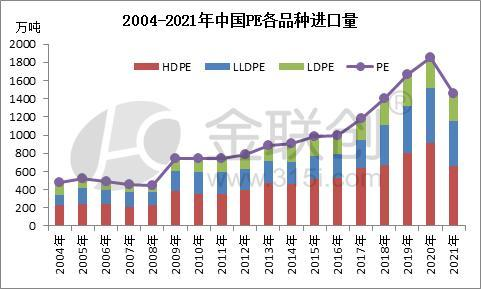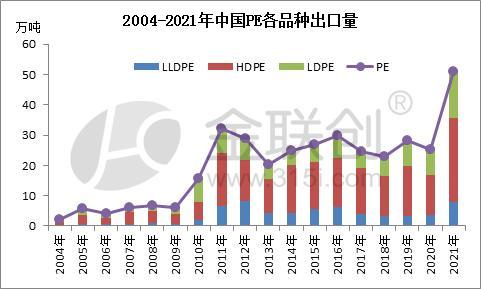read: 1154 time:2022-04-07 13:42:27 from:
The change of China's import volume from 2004-2021 can be seen in four phases of China's PE import volume trend since 2004, as detailed below.

The first stage is 2004-2007, when China's demand for plastics was low and PE import volume maintained a low level of operation, and China's PE import volume was low in 2008 when new domestic installations were more concentrated and suffered a serious financial crisis.
The second phase is 2009-2016, China's PE imports entered a stable growth phase after a significant increase. 2009, due to the domestic and foreign capital injection bailout, global liquidity, domestic general trade volume increased, speculative demand was hot, imports increased significantly, with a growth rate of 64.78%, followed by the exchange rate reform in 2010, the RMB exchange rate continued to appreciate, coupled with the ASEAN Free Trade Area The framework agreement came into effect and the import cost was reduced, so the import volume from 2010 to 2013 remained high and the growth rate maintained a high trend. By 2014, the new domestic PE production capacity increased significantly, and the domestic general-purpose material production increased rapidly; in 2016, the West officially lifted the sanctions on Iran, and Iranian sources were more willing to export to Europe with higher prices, at which time the growth of domestic import volume dropped back.
The third stage is 2017-2020, China's PE import volume rose sharply again in 2017, domestic and foreign PE production capacity is increasing and more concentrated overseas production, China, as a major PE consuming country, is still an important export for world production capacity release. 2017 since China's PE import volume growth slope increased significantly, to 2020, China's large refining and light hydrocarbon new devices have been launched, domestic However, from the perspective of consumption, overseas demand is more seriously affected by the "new crown epidemic", while the situation of China's epidemic prevention and control is relatively stable and demand takes the lead in recovery, overseas resources are more inclined to supply to the Chinese market at low prices, so China's PE import volume maintains medium to high growth, and in 2020 China's PE import volume reaches 18.53 million tons. However, the driving factors for the increase of PE import volume at this stage are mainly for the consumption of goods rather than driven by the immediate demand, and the competitive pressure from both domestic and overseas markets gradually emerges.
In 2021, China's PE import trend enters a new phase, and according to customs statistics, China's PE import volume will be about 14.59 million tons in 2021, down 3.93 million tons or 21.29% from 2020. Due to the influence of global epidemic, international shipping capacity is tight, ocean freight rate has increased significantly, overlapping with the influence of inverse price of polyethylene inside and outside the market, domestic PE import volume will be significantly reduced in 2021. 2022 China's production capacity will continue to expand, the arbitrage window inside and outside the market is still difficult to open, international PE import volume will remain low, and China's PE import volume may enter the downward channel in the future.

From 2004-2021 China PE export volume of each species, the overall import volume of China PE is low and the amplitude is large.
From 2004 to 2008, China's PE export volume was within 100,000 tons. After June 2009, the national export tax rebate rate for some plastics and their products, such as other primary-shaped ethylene polymers, was raised to 13%, and domestic PE export enthusiasm increased.
In 2010-2011, the increment of domestic PE export was obvious, but after that, domestic PE export encountered bottleneck again, despite the increasing domestic PE production capacity, there is still a large gap in China PE supply, and it is difficult to have a large increase in export based on the cost, quality demand and transportation condition constraints.
From 2011 to 2020, China's PE export volume oscillated narrowly, and its export volume was basically between 200,000-300,000 tons. 2021, China's PE export volume surged, and the total annual export reached 510,000 tons, an increase of 260,000 tons compared with 2020, an increase of 104% year-on-year.
The reason is that after 2020, China's large refining and light hydrocarbon plants will be launched centrally, and the production capacity will be effectively released in 2021, and China's PE production will increase, especially HDPE varieties, with more resources scheduled for new plants and increased market competition pressure. The supply is tightening, and the sale of Chinese PE resources to South America and other places is increasing.
The continuous growth of production capacity is a serious problem that has to be faced on the supply side of Chinese PE. For now, due to the constraints of cost, quality demand and transportation conditions, it is still difficult to export domestic PE, but with the continuous growth of domestic production capacity, it is crucial to strive for overseas sales. The pressure of global PE competition in the future is becoming more and more severe, and the pattern of supply and demand in domestic and foreign markets still needs further attention.

Jincheng Petrochemical's 300000 ton polypropylene plant successfully trial production, 2024 polypropylene market analysis

The ABS market remains sluggish, what is the future direction?

Market differentiation of bisphenol A intensifies: prices rise in East China, while prices generally decline in other regions

The production method and process flow of silicone acrylic lotion, and what are the common raw materials